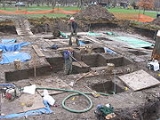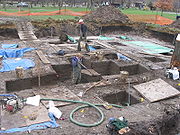
Edgewater Park Site
Encyclopedia
The Edgewater Park Site is a 3,800-year-old Late Archaic campsite situated along the Iowa River
in Coralville
, Iowa
, United States
. Plant remains recovered from the site suggest the inhabitants were in the earliest stages of adapting domesticated plants.
 Excavations revealed a small encampment of two hearth
Excavations revealed a small encampment of two hearth
s and areas for faunal and stone tool
production. Other features identified include a discard area and a deep feature of unknown function. Lithic analysis
reveals that the site occupants probably recently traveled along the Iowa River from the north center of the state and were engaged in late-stage tool manufacture and maintenance. Floral analysis indicates the site occupation occurred during the warm half of the year and that the occupants utilized little barley, a non-local plant which was later cultivated, and barnyard grass, a local plant probably also later cultivated. This site is interpreted as a short-term, late warm-season occupation of people migrating down the Iowa River, possibly towards winter encampments in what is now the southeast part of the state.
Iowa River
The Iowa River is a tributary of the Mississippi River in the state of Iowa in the United States. It is about long and is open to small river craft to Iowa City, about from its mouth...
in Coralville
Coralville, Iowa
Coralville is a city in Johnson County, Iowa, United States. It is a suburb of Iowa City and part of the Iowa City Metropolitan Statistical Area...
, Iowa
Iowa
Iowa is a state located in the Midwestern United States, an area often referred to as the "American Heartland". It derives its name from the Ioway people, one of the many American Indian tribes that occupied the state at the time of European exploration. Iowa was a part of the French colony of New...
, United States
United States
The United States of America is a federal constitutional republic comprising fifty states and a federal district...
. Plant remains recovered from the site suggest the inhabitants were in the earliest stages of adapting domesticated plants.

Hearth
In common historic and modern usage, a hearth is a brick- or stone-lined fireplace or oven often used for cooking and/or heating. For centuries, the hearth was considered an integral part of a home, often its central or most important feature...
s and areas for faunal and stone tool
Stone tool
A stone tool is, in the most general sense, any tool made either partially or entirely out of stone. Although stone tool-dependent societies and cultures still exist today, most stone tools are associated with prehistoric, particularly Stone Age cultures that have become extinct...
production. Other features identified include a discard area and a deep feature of unknown function. Lithic analysis
Lithic analysis
In archaeology, lithic analysis is the analysis of stone tools and other chipped stone artifacts using basic scientific techniques. At its most basic level, lithic analyses involve an analysis of the artifact’s morphology, the measurement of various physical attributes, and examining other visible...
reveals that the site occupants probably recently traveled along the Iowa River from the north center of the state and were engaged in late-stage tool manufacture and maintenance. Floral analysis indicates the site occupation occurred during the warm half of the year and that the occupants utilized little barley, a non-local plant which was later cultivated, and barnyard grass, a local plant probably also later cultivated. This site is interpreted as a short-term, late warm-season occupation of people migrating down the Iowa River, possibly towards winter encampments in what is now the southeast part of the state.

